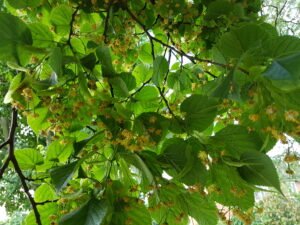As something I’ve been aware of for some time, and looking out for Linden tree (Lime) flowers in the local area; I was pleased to find a big, old Linden tree not far from where I live. And it was positively overloaded with flowers.
Just for clarification, with these trees the name “Lime tree” and “Linden tree” are interchangeable. They are not the tree which bears the lime fruit. Also, I’ve titled this Tilia x europia (common Lime) because that’s the tree I found. It’s equally applicable to Tilia platyphyllos (Large-leaved Lime) and Tilia cordata (Small-leaved, Lime).
The flowers are usually within reaching distance anyway (unless the lower branches have been trimmed), but as an added bonus, this tree was on a slope too, so a lot of branches were at waist height, for easy picking.

Identification
- Common Lime is a deciduous, broadleaf tree, native to the UK and quite common.
- The bark is pale grey/brown and has irregular ridges.
- It is quite common to find multiple shoots growing out from the base of the tree.
- Twigs are hairy and brown, but can turn reddish when in the sun.
- Leaf buds are red with two scales; one small and one large. The buds look a little like a boxing glove.
- The leaves are dark green and heart shaped, usually six to ten centimetres. The base of the leaf is asymmetrical and the underside has tufts of small white hairs at vein axils.
- The flowers are white-yellow, five petals, hang in clusters of two to five, hang from a bract, and have both male and female reproductive parts.
Uses
So why am I going on about these Linden tree flowers? Well, in the past, Linden Flowers have been used as a herbal remedy for all kinds of ailments, including high blood pressure, migraine, headaches, digestive complaints, colds, flu, insomnia, liver and gallbladder disease, itchy skin, joint pains and anxiety.
Apparently, during the war, Linden was used to make a soothing, relaxing tea. You can imagine why people might have wanted it then!
Personally, I have been known to suffer from mild anxiety, insomnia (of a kind) and joint pains, so I’ll be giving it a try (after doing my own research).
As I understand it, it also makes a nice drink, and as an occasional thing isn’t likely to do any harm
Warning
As always, you absolutely must do your own research before diving into believing the first thing you read online, and also check with your doctor too. Apparently some people have reported allergies to Linden, but apart from that Linden tea is pretty harmless stuff.
What to do with Linden tree flowers
Make sure that you pick the pale green bract that comes with the flowers – you’ll need it all. Also, pick responsibly. Whilst it’s unlikely that you could over-harvest a tree, if you need a lot, make sure you take small amounts from several trees.

Next step – either dry it for future use (in the sun on a sheet, in your oven, or in your electric dehydrator), or make a tea from it immediately.
Tea
Put a few handfuls of flowers in a pan with one to two litres of water.
Bring to the boil, cover and remove from the heat, and leave it overnight.
Strain out the blossoms and keep the infusion in the fridge for up to three days. You can drink it cold, or reheat it. You can freeze the tea to keep it for longer, or make it into an elixir (thanks to the ladies at www.handmadeapothecary.co.uk for the idea) by adding 50% spiced rum to use as a cold remedy (take 50mls in hot water and go to bed to sweat it out).
Next steps
Coming soon – I plan to make my linden tree flower tea on video…

